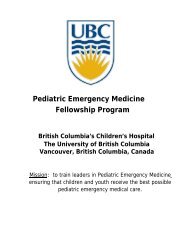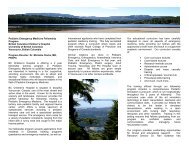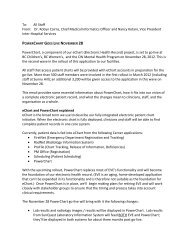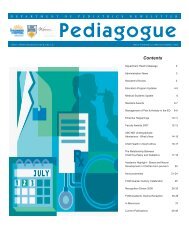UBC Department of Pediatrics Year 3 Student Orientation Manual
UBC Department of Pediatrics Year 3 Student Orientation Manual
UBC Department of Pediatrics Year 3 Student Orientation Manual
You also want an ePaper? Increase the reach of your titles
YUMPU automatically turns print PDFs into web optimized ePapers that Google loves.
O (Objective):<br />
‣ The information gathered from the physical examination and from the tests.<br />
• Begin with weight (if new weight available), vitals. If febrile,<br />
maximum temperature in last 24 hours.<br />
• Total input and output – especially in a child admitted with dehydration<br />
or with a renal problem. Also important in children not gaining adequate<br />
weight due to any reason.<br />
• Physical examination conducted on that day. Include all pertinent<br />
positives and negatives.<br />
• New laboratory results and other tests done with results i.e, renal<br />
ultrasound – normal. Also mention tests already done with pending results.<br />
A (Assessment):<br />
‣ Assessment <strong>of</strong> the patient – what you consider the problems with the patient,<br />
with the most relevant problem listed first.<br />
‣ It is also the summary <strong>of</strong> how the patient is doing and what has changed from<br />
previous day.<br />
P (Plan):<br />
‣ Identify the plans for the patient according to each problem.<br />
‣ Some people like to merge assessment and plan together.<br />
‣ The most significant problem should be mentioned first.<br />
‣ This section should include all the medications, lab tests to be ordered and to be followed,<br />
consults to be asked.<br />
‣ It is very important to write the plan after the rounds as most <strong>of</strong> the decisions<br />
are made in the rounds.









